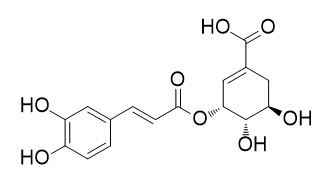3-O-Caffeoylshikimic acid
3-O-Caffeoylshikimic acid shows anti-oxidative activity, it also shows potent antiproliferative activities with IC(50) values among 5-150 μM against HepG2 human liver cancer, HL-60 human myeloid leukemia, K562 human myeloid leukemia, and CNE-1 human nasopharyngeal carcinoma cell lines.
Inquire / Order:
manager@chemfaces.com
Technical Inquiries:
service@chemfaces.com
Tel:
+86-27-84237783
Fax:
+86-27-84254680
Address:
1 Building, No. 83, CheCheng Rd., Wuhan Economic and Technological Development Zone, Wuhan, Hubei 430056, PRC
Providing storage is as stated on the product vial and the vial is kept tightly sealed, the product can be stored for up to
24 months(2-8C).
Wherever possible, you should prepare and use solutions on the same day. However, if you need to make up stock solutions in advance, we recommend that you store the solution as aliquots in tightly sealed vials at -20C. Generally, these will be useable for up to two weeks. Before use, and prior to opening the vial we recommend that you allow your product to equilibrate to room temperature for at least 1 hour.
Need more advice on solubility, usage and handling? Please email to: service@chemfaces.com
The packaging of the product may have turned upside down during transportation, resulting in the natural compounds adhering to the neck or cap of the vial. take the vial out of its packaging and gently shake to let the compounds fall to the bottom of the vial. for liquid products, centrifuge at 200-500 RPM to gather the liquid at the bottom of the vial. try to avoid loss or contamination during handling.
Int J Med Sci.2020, 17(5):626-631
Molecules.2019, 24(24),4583
Sci Rep.2021, 11(1):11936.
Nutrients2020, 12(3):811.
Exp Biol Med (Maywood).2019, 244(18):1665-1679
Asian Pac J Cancer Prev.2021, 22(S1):97-106.
J Mol Recognit.2020, 33(2):e2819
Nature Ecology & Evolution2020, doi: 10.1038
Int J Biol Macromol.2021, 199:189-200.
Eur J Neurosci.2021, 53(11):3548-3560.
Related and Featured Products
Fitoterapia. 2012 Jan;83(1):104-9.
Bioactive phenolics from the fruits of Livistona chinensis.[Pubmed:
22019335]
This study investigated the antioxidant and cytotoxic activity of the phenolics isolated from the fruits of Livistona chinensis.
METHODS AND RESULTS:
Four new compounds, 1-{ω-isoferul[6- (4-hydroxybutyl)pentadecanoic acid]}-glycerol (1), E-[6'-(5″-hydroxypentyl)tricosyl]-4-hydroxy-3-methoxycinnamate (2), 2-(3'-hydroxy-5'-methoxyphenyl)-3-hydroxylmethyl-7-methoxy-2,3-dihydrobenzofuran-5- carboxylic acid (3), 7-hydroxy-5,4'-dimethoxy-2-arylbenzofuran (4), together with eleven known phenolics (5-15), were isolated and identified. Among these compounds, 1-4, 5-O-caffeoylshikimic acid (5), caffeic acid (7), and 3-O-Caffeoylshikimic acid (8) showed potent antioxidant activity. 1-5, and 8 showed potent antiproliferative activities with IC(50) values among 5-150 μM against HepG2 human liver cancer, HL-60 human myeloid leukemia, K562 human myeloid leukemia, and CNE-1 human nasopharyngeal carcinoma cell lines.
CONCLUSIONS:
On the basis of these findings, it could be proposed that the fruits of L. chinensis may serve as attractive mines of powerful anticancer and antioxidant agents for various purposes.
Food Res Int. 2018 Jun;108:226-236.
Rapid discrimination of raw and sulfur-fumigated Smilax glabra based on chemical profiles by UHPLC-QTOF-MS/MS coupled with multivariate statistical analysis.[Pubmed:
29735052]
Smilax glabra (SG) is commonly used as a traditional edible herb in eastern Asia. Recently, sulfur-fumigation has been frequently used in order to obtain better color and a longer storage lifetime. However, the chemical alterations caused by this process remain unknown. The aim of this research was to explore potential chemical differences between non-fumigated and sulfur-fumigated SG samples.
METHODS AND RESULTS:
A novel approach was developed by using ultra-high-performance liquid chromatography-quadrupole/time-of-flight mass spectrometry (UHPLC-QTOF-MS/MS) with principal component analysis (PCA) and orthogonal partial squared discriminant analysis (OPLS-DA). Fifty-eight compounds were unambiguously characterized or tentatively identified in the chemical profiles for the first time. Six newly generated sulfur-containing compounds, namely glucosyringic acid sulfate, 5-O-caffeoylshikimic acid sulfite, 3-O-Caffeoylshikimic acid sulfite, 5-O-caffeoylshikimic acid sulfate, 3-O-Caffeoylshikimic acid sulfate and astilbin sulfate, were screened out to be the most characteristic markers for distinguishing non-fumigated and sulfur-fumigated SG.
CONCLUSIONS:
This newly proposed approach can not only be applied for exploring chemical markers but can also be used to investigate the chemical transformation mechanism associated with sulfur for other edible herbs.



